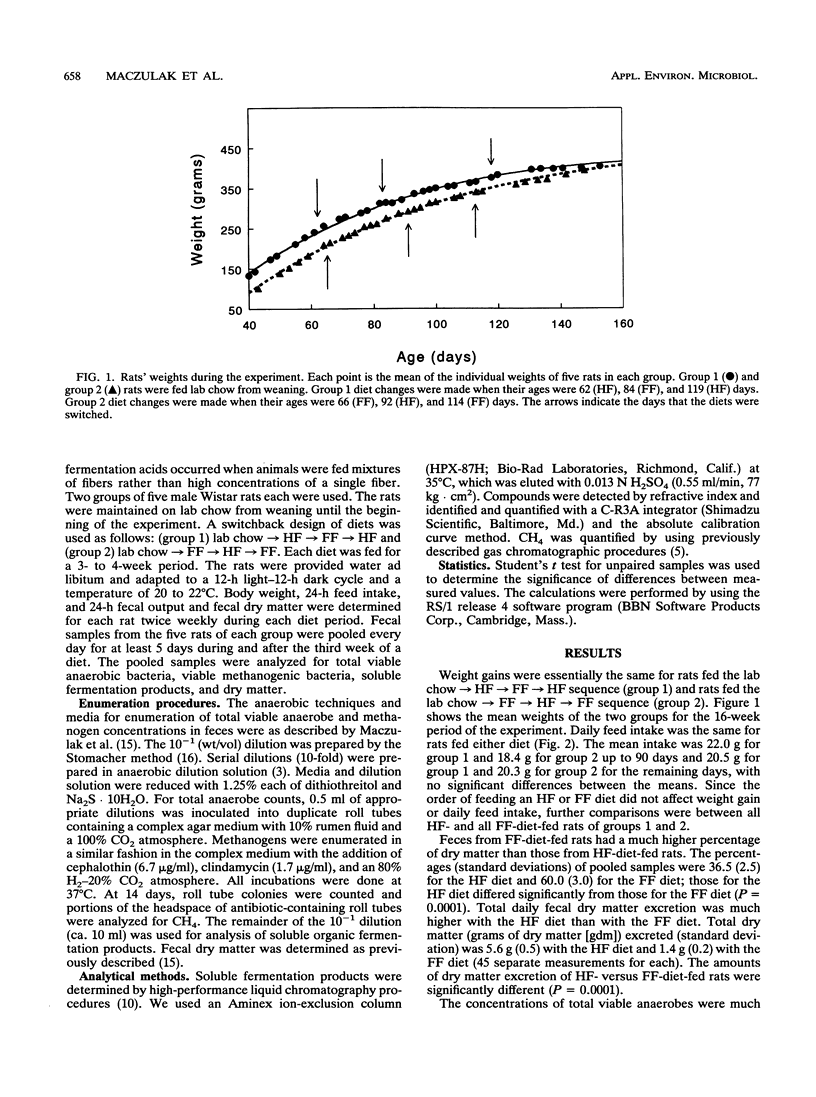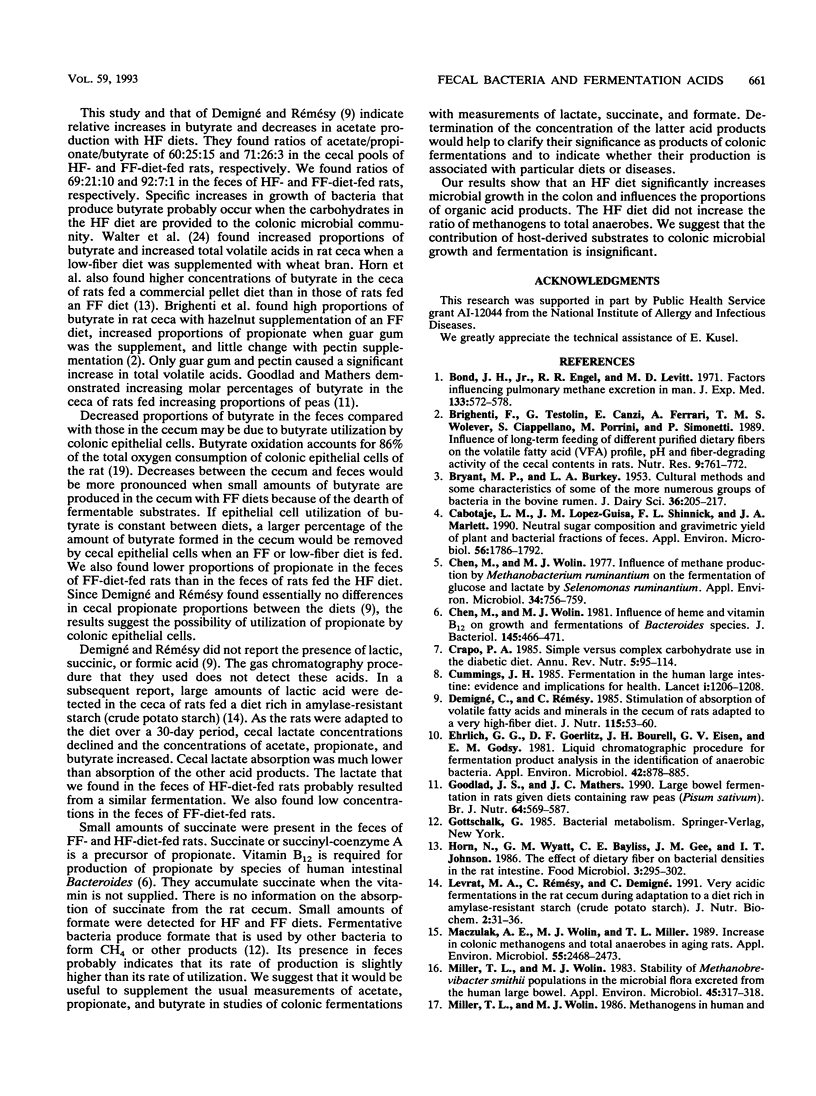Abstract
We investigated the impact of dietary fiber on the fecal output of microorganisms and microbial fermentation products of rats. Two groups of five male Wistar rats were fed high-fiber (HF) and fiber-free (FF) diets in the following order: (group 1) lab chow-->HF-->FF-->HF and (group 2) lab chow-->FF-->HF-->FF. Daily fecal output of total viable anaerobes was 71 times higher with the HF diet. Daily output of methanogens was 1.4 times higher for the HF diet than for the FF diet. Daily excretion of total fermentation acid products (acetate, propionate, butyrate, lactate, succinate, and formate) was 2.4 and 0.1 mmol for HF and FF diets, respectively. The ratios of acetate/propionate/butyrate were 69:21:10 for the HF diet and 92:7:1 for the FF diet. The results show that an HF diet significantly increases microbial growth in the colon and influences the proportions of organic acid products. The HF diet did not increase the ratio of methanogens to total anaerobes. We suggest that the contribution of host-derived substrates to colonic microbial growth and fermentation is insignificant.
Full text
PDF





Selected References
These references are in PubMed. This may not be the complete list of references from this article.
- Bond J. H., Jr, Engel R. R., Levitt M. D. Factors influencing pulmonary methane excretion in man. An indirect method of studying the in situ metabolism of the methane-producing colonic bacteria. J Exp Med. 1971 Mar 1;133(3):572–588. doi: 10.1084/jem.133.3.572. [DOI] [PMC free article] [PubMed] [Google Scholar]
- Cabotaje L. M., López-Guisa J. M., Shinnick F. L., Marlett J. A. Neutral sugar composition and gravimetric yield of plant and bacterial fractions of feces. Appl Environ Microbiol. 1990 Jun;56(6):1786–1792. doi: 10.1128/aem.56.6.1786-1792.1990. [DOI] [PMC free article] [PubMed] [Google Scholar]
- Chen M., Wolin M. J. Influence of CH4 production by Methanobacterium ruminantium on the fermentation of glucose and lactate by Selenomonas ruminantium. Appl Environ Microbiol. 1977 Dec;34(6):756–759. doi: 10.1128/aem.34.6.756-759.1977. [DOI] [PMC free article] [PubMed] [Google Scholar]
- Chen M., Wolin M. J. Influence of heme and vitamin B12 on growth and fermentations of Bacteroides species. J Bacteriol. 1981 Jan;145(1):466–471. doi: 10.1128/jb.145.1.466-471.1981. [DOI] [PMC free article] [PubMed] [Google Scholar]
- Crapo P. A. Simple versus complex carbohydrate use in the diabetic diet. Annu Rev Nutr. 1985;5:95–114. doi: 10.1146/annurev.nu.05.070185.000523. [DOI] [PubMed] [Google Scholar]
- Demigné C., Rémésy C. Stimulation of absorption of volatile fatty acids and minerals in the cecum of rats adapted to a very high fiber diet. J Nutr. 1985 Jan;115(1):53–60. doi: 10.1093/jn/115.1.53. [DOI] [PubMed] [Google Scholar]
- Ehrlich G. G., Goerlitz D. F., Bourell J. H., Eisen G. V., Godsy E. M. Liquid chromatographic procedure for fermentation product analysis in the identification of anaerobic bacteria. Appl Environ Microbiol. 1981 Nov;42(5):878–885. doi: 10.1128/aem.42.5.878-885.1981. [DOI] [PMC free article] [PubMed] [Google Scholar]
- Goodlad J. S., Mathers J. C. Large bowel fermentation in rats given diets containing raw peas (Pisum sativum). Br J Nutr. 1990 Sep;64(2):569–587. doi: 10.1079/bjn19900057. [DOI] [PubMed] [Google Scholar]
- Maczulak A. E., Wolin M. J., Miller T. L. Increase in colonic methanogens and total anaerobes in aging rats. Appl Environ Microbiol. 1989 Oct;55(10):2468–2473. doi: 10.1128/aem.55.10.2468-2473.1989. [DOI] [PMC free article] [PubMed] [Google Scholar]
- Miller T. L., Wolin M. J. Stability of Methanobrevibacter smithii populations in the microbial flora excreted from the human large bowel. Appl Environ Microbiol. 1983 Jan;45(1):317–318. doi: 10.1128/aem.45.1.317-318.1983. [DOI] [PMC free article] [PubMed] [Google Scholar]
- Roediger W. E. Utilization of nutrients by isolated epithelial cells of the rat colon. Gastroenterology. 1982 Aug;83(2):424–429. [PubMed] [Google Scholar]
- Royall D., Wolever T. M., Jeejeebhoy K. N. Clinical significance of colonic fermentation. Am J Gastroenterol. 1990 Oct;85(10):1307–1312. [PubMed] [Google Scholar]
- Scheppach W., Sommer H., Kirchner T., Paganelli G. M., Bartram P., Christl S., Richter F., Dusel G., Kasper H. Effect of butyrate enemas on the colonic mucosa in distal ulcerative colitis. Gastroenterology. 1992 Jul;103(1):51–56. doi: 10.1016/0016-5085(92)91094-k. [DOI] [PubMed] [Google Scholar]
- Stephen A. M., Cummings J. H. The microbial contribution to human faecal mass. J Med Microbiol. 1980 Feb;13(1):45–56. doi: 10.1099/00222615-13-1-45. [DOI] [PubMed] [Google Scholar]
- Walter D. J., Eastwood M. A., Brydon W. G., Elton R. A. An experimental design to study colonic fibre fermentation in the rat: the duration of feeding. Br J Nutr. 1986 May;55(3):465–479. doi: 10.1079/bjn19860054. [DOI] [PubMed] [Google Scholar]
- Weaver G. A., Krause J. A., Miller T. L., Wolin M. J. Incidence of methanogenic bacteria in a sigmoidoscopy population: an association of methanogenic bacteria and diverticulosis. Gut. 1986 Jun;27(6):698–704. doi: 10.1136/gut.27.6.698. [DOI] [PMC free article] [PubMed] [Google Scholar]
- Whitelaw A., Sleath K. Myth of the marsupial mother: home care of very low birth weight babies in Bogota, Colombia. Lancet. 1985 May 25;1(8439):1206–1208. doi: 10.1016/s0140-6736(85)92877-6. [DOI] [PubMed] [Google Scholar]


